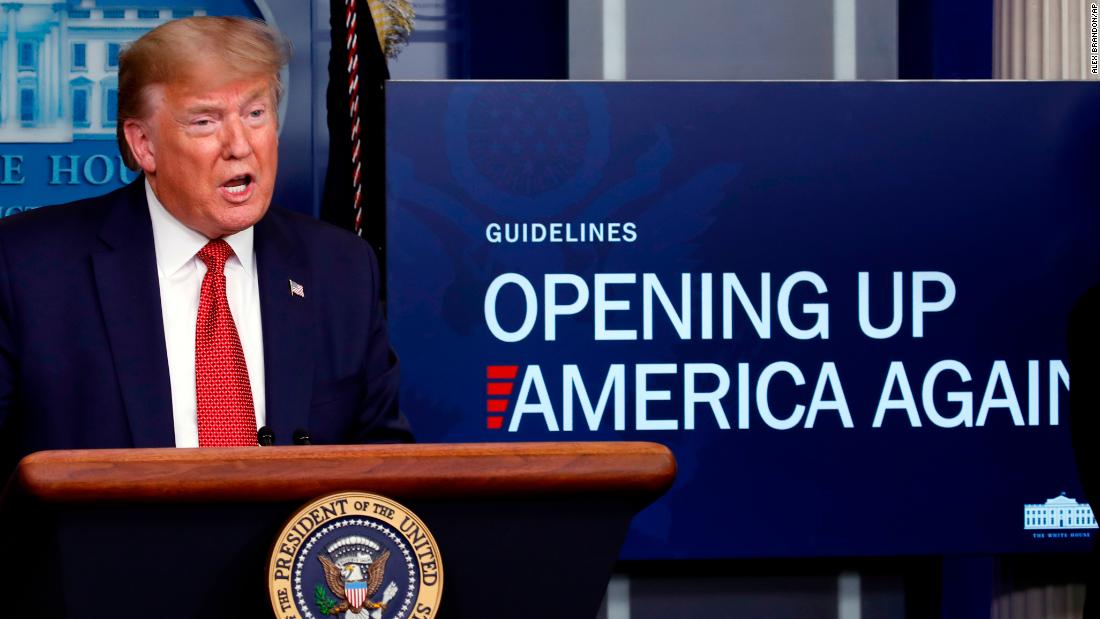
Washington (CNN)He alone can’t fix it.
But instead it came across more as a victory lap over a crisis that is not yet nearly over. And it exposed the tied hands of a President now hostage to a deadly pandemic that is not yet under control, his own inability to provide diagnostic testing that could ease a safe opening and state governors who will make all determinations on when to ease the shutdowns.
Trump announced a three-phase plan to restore economic life, state by state, one careful step at a time. The new recommendations crafted with scientists, experts and medical professionals suggested that for many states, the kind of roaring reopening previewed by Trump in recent days will cede to a long, slow trudge towards a new kind of normality.
That will be grim news for the 22 million Americans who have now made first time claims for unemployment benefits since mid-March, encapsulating the hideous human consequences of a decision to shutter a cruising economy to save lives.
Trump said that 29 states were “in the ballgame” to open soon. But even before his announcement, big, economically crucial states like New York, New Jersey and California had made clear that their social distancing guidelines would not be relaxed for weeks. Other states that currently haven’t seen a heavy toll from the novel coronavirus may still be weeks away from their peak — and a relaxing of restrictions, apparently encouraged by the President, could leave them more vulnerable to the advance of the virus.
“If you look at Montana, Wyoming, North Dakota — that’s a lot different than New York, it’s a lot different than New Jersey,” Trump said.
The new guidelines represented an implicit recognition by the Trump his own repeated assertion this week that he could force states open was empty. Indeed, as the President told state governors on a call on Thursday afternoon “you call your own shots.”
Trump effectively ceded the critical task of testing to the states and the new guidelines were mere suggestions and advisories, not orders. His move sat uneasily with the image of a CEO president — fixing problems, and getting others to bend to his will — that has underpinned his image in business and politics.
It was also noticeable that Trump did not renew his constitutionally murky threat from the day before to shut down Congress if Democrats did not remove obstacles to confirming his nominees.
Still, Trump appeared, for now at least to have heeded the advice of his top public health officials. In the past, however, he has often appeared to undercut their advice in subsequent days after announcements.
A subdued Trump appeared in the White House briefing room to announce “the next front in our war, which we are calling opening up America again.”
“We’re opening up our country. And we have to do that. America wants to be open, and Americans want to be open,” the President said.
Trump and Vice President Mike Pence styled their announcement as a lofty, coordinated, science-based program drawn up by an engaged President to authorize states to pry open their societies. It was also clearly aimed at conservative media and base voters agitating for a return to normality and accuse what they see as elites — like the top public health official on Trump’s team — of infringing American freedoms with social distancing orders.
“Governors will be empowered to tailor an approach that meets the diverse circumstances of their own states, every state is very different. They’re all beautiful, we love them all, but they’re very, very different,” Trump said.
“They need to remain closed, we will allow them to do that. And if they believe it is time to reopen, we will provide them the freedom and guidance to accomplish that task and very, very quickly, depending on what they want to do.”
Like everything to do with Trump, his announcement will be viewed in the eye of the beholder. Critics will see further inconsistencies and retreats. His core supporters will likely view his appearance as epitomizing strong leadership.
States were already assessing their options before Trump weighed in
The biggest takeaway of Thursday evening’s event was regarding its relevance. Many state governors have already laid out more advanced thinking on what is likely to be an agonizingly slow process of opening up. They don’t need Trump’s permission to open up or stay closed.
Two groups of states on the coasts were Thursday joined by a bipartisan consortium in the Midwest to coordinate the restoration of normal life — a far more powerful bloc of political influence than that currently being exerted on the crisis by the White House.
It is an invidious position for Trump, a President who is about to ask for a second term, to find himself in — especially one who is almost totally reliant on wavering voters overlooking reservations about his personality in recognition of the previously strong economy. The phased opening also raises the question of how the President who has spent days assuring Americans that there is light at the end of the tunnel will react if governors act cautiously.
Had Trump performed strongly during the crisis, anticipated its devastating impact and prepared accordingly, he might be in a better position to shrug off any political downsides of his position. He is instead left in a familiar place — needing to throw out distractions, seek scapegoats, obscure the truth about his own leadership and supply a regular stream of outrage to his political base.
Trump’s political maneuverings this week culminating in his announcement on Thursday made clear that his primary role now will be to create a familiar, if misleading, mythology around his new leadership in the crisis.
He claimed credit, for example, for saving millions of lives, based on social distancing regulations to cope with a disease that he had long minimized. The President lashed out at the press, China, the World Health Organization and even Voice of America — seeking to distract from his own failings. And on Thursday he declined to criticize demonstrators who descended on the Michigan state capital, Lansing, in protest at Democratic Gov. Gretchen Whitmer’s stay-at-home measures in a state that has been one of the worst-hit in the nation.
Medical experts and think tanks who have laid out suggested plans for a slow reopening of the economy have suggested that the only safe way to proceed is to conduct millions of tests per day or per week to isolate those who are infected,to trace clusters of infection and to clear those who are immune to return to work.
On CNN’s Global Town Hall, “Coronavirus: Facts and Fears,” Thursday, Dr. Deborah Birx — an HIV researcher who is the White House’s coronavirus response coordinator — laid bare that Trump’s earlier bluster on unilaterally forcing states to reopen their economies was toothless.
Birx said during the town hall that the White House’s guidelines are meant to give the states time to set up testing systems to find infected individuals and then trace their contacts in order to limit the virus’s spread. The states and federal government have to work together, she said.
“I know it’s been dynamic — it continues to be a work in progress — but it’s really a partnership between the state and the federal government,” Birx said.
That ability to test — in large numbers, quickly — remains out of reach.
Back in early March, Pence said that four million tests would be available within days. But the government has failed with its private sector providers to scale up the necessary regime to provide for everyone who needs a test. On Thursday, for instance, Pence said that “it is our expectation that we will have tested more than five million Americans before the end of the month of April.”
Delaware Democratic Gov. John Carney, who was on a call with Trump and other governors, told CNN’s Wolf Blitzer on “The Situation Room” on Thursday that “so many states … don’t have the testing capacity really to implement this phased-in approach to recovery.”
New York Democratic Gov. Andrew Cuomo said that testing was beginning to scale up in his state but “the plain reality” was that states needed federal help.
“If we work together we can do better than any of us alone,” he said.
Trump, who is largely handing over responsibility for testing to individual states, refused to admit that the system was deficient on Thursday.
“We do have the capacity,” he insisted.
Still, there was some good news on testing on Thursday.
Detroit Mayor Mike Duggan told CNN’s Poppy Harlow that new rapid tests manufactured by Abbot Labs had been “unbelievable” and helped him put 700 police officers back on the beat.
“The Abbot test gives you a result in 15 minutes,” he said. “It shows you what this country has been missing, our police department, fire department, back to full force, really because of Abbott Labs and 15 minute tests.”
Read more: https://www.cnn.com/2020/04/17/politics/donald-trump-coronavirus-economy-politics/index.html












